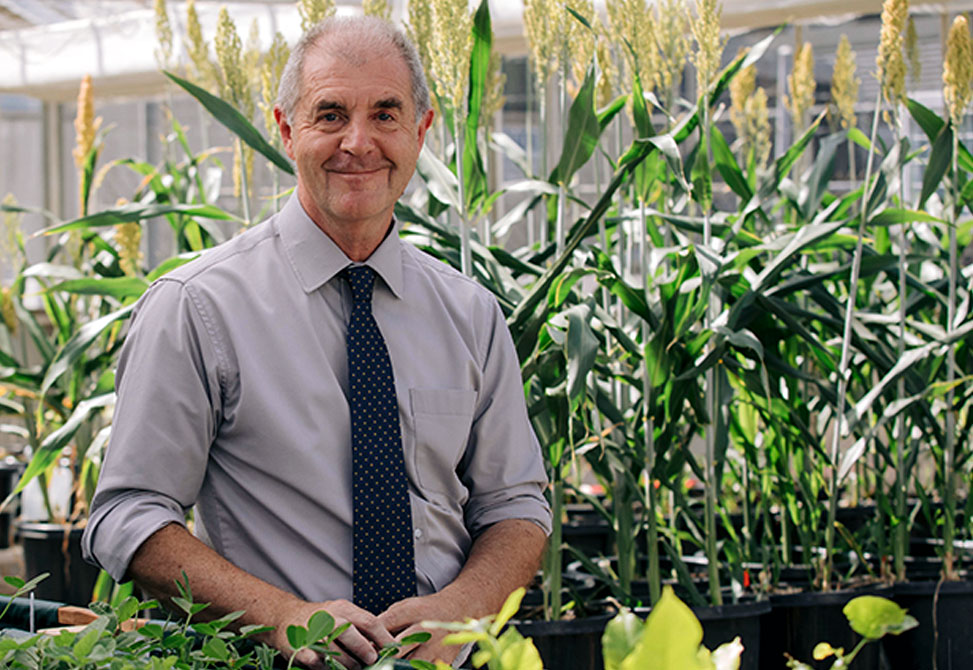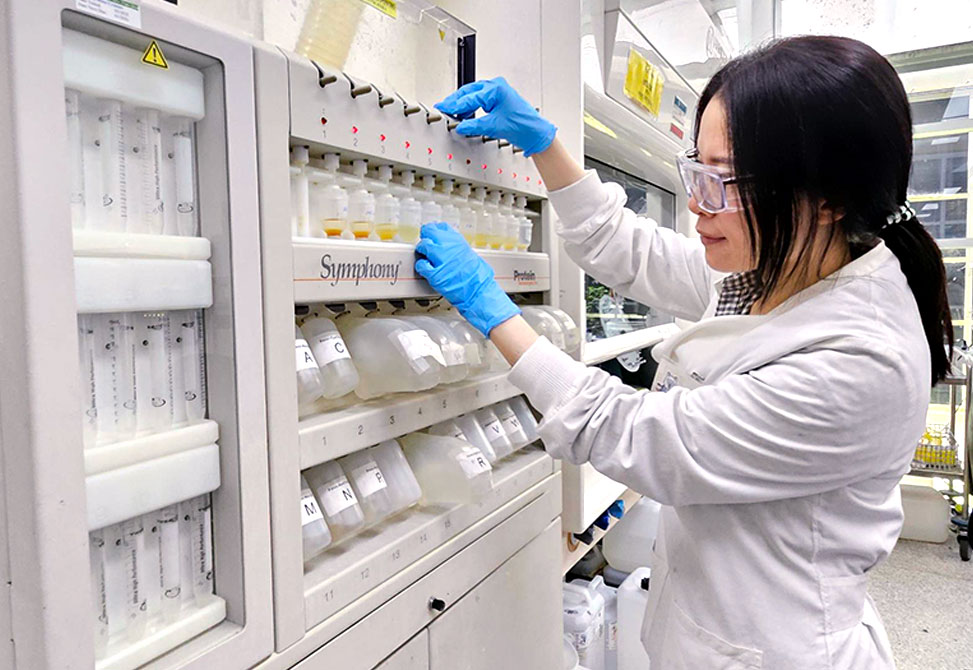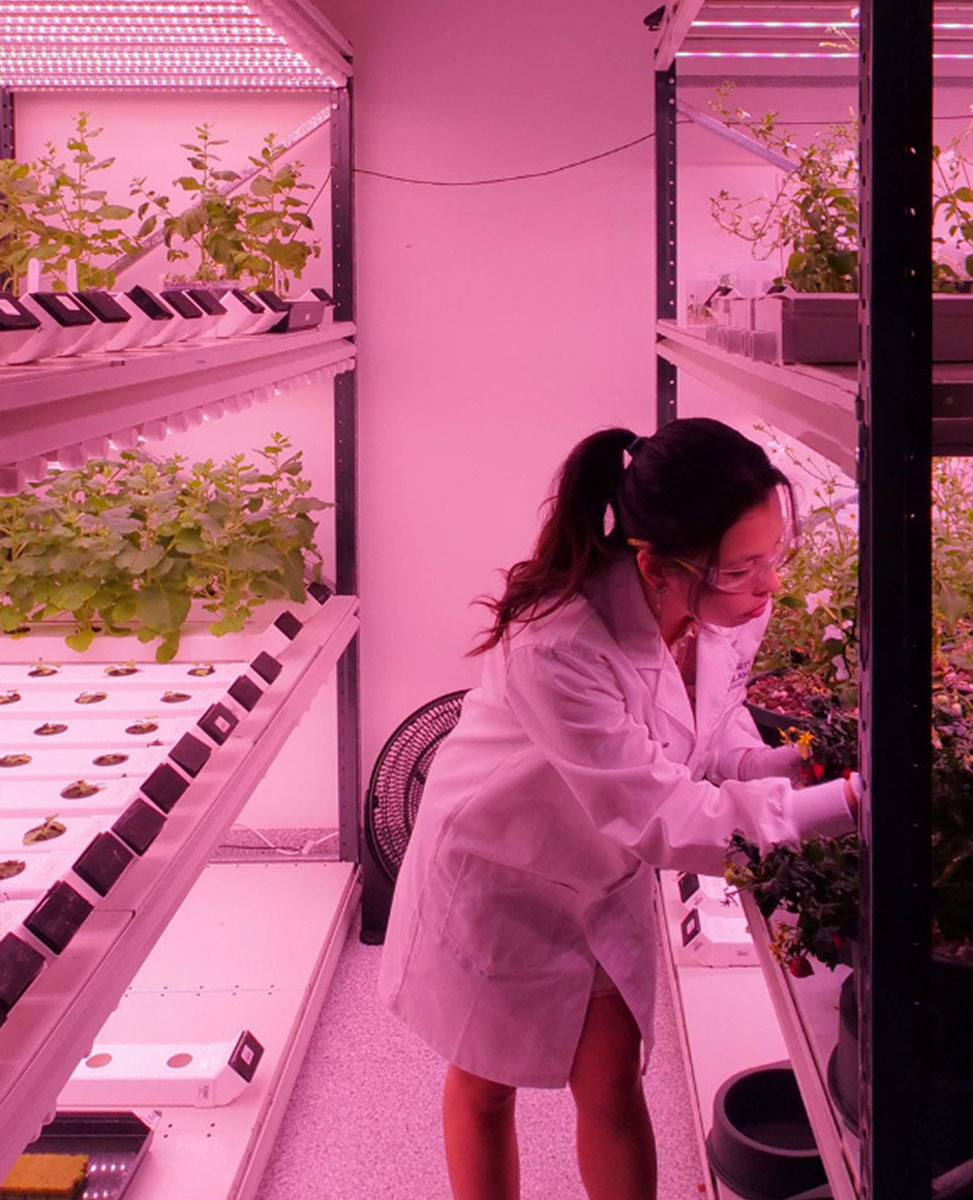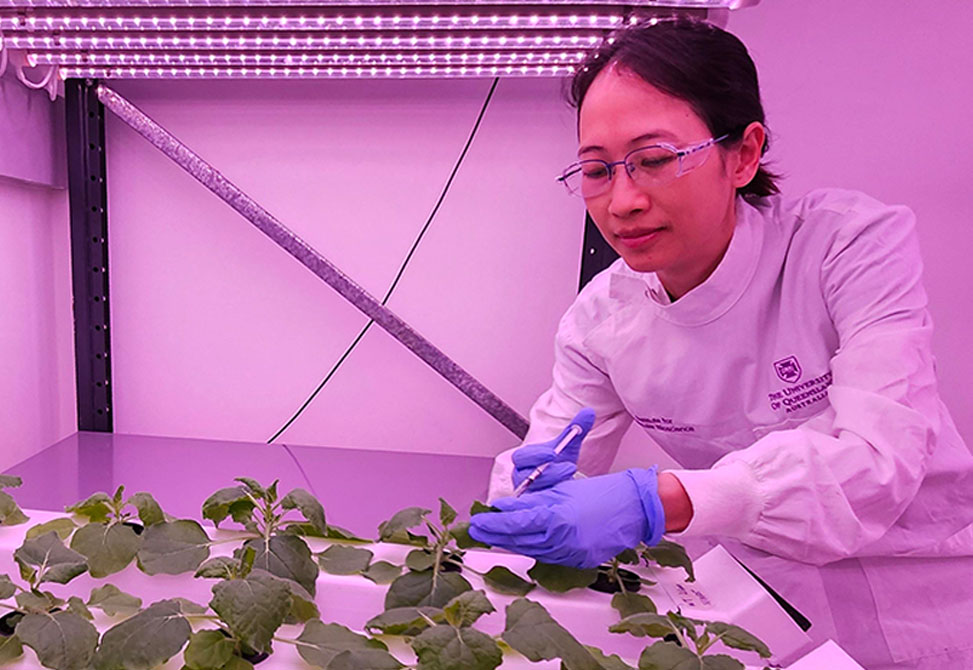Lab of the Month – The Craik Group
The interconnected, organized framework not only defines the topography of the cyclotide family of disulfide-rich cyclic peptides; it also defines the community of researchers and staff that make up the Craik lab, located at the Institute for Molecular Bioscience, IMB, at the University of Queensland, Australia.
Our team gathers a diverse group of individuals from across the globe, which reflects on the international reach of our lab, and the importance of our discoveries to influence scientists to research and collaborate with us. The Craik lab comprises experts in synthetic peptide chemistry, molecular biochemistry and pharmacology, cell biology, and plant biology. The breadth of knowledge in our lab is vital in supporting a dynamic and interdisciplinary environment that encourages continuous learning, as well as fruitful collaboration with industry partners.

Professor David J. Craik AO, FAA, FRS, leads the researchers in the Craik lab. David also serves as Director for the Centre for Innovations in Peptides and Protein Science, CIPPS, a national research centre funded through the Australian Research Council’s Centres of Excellence scheme.
Throughout his career, David has been developing next-generation therapeutics and eco-friendly tools using peptides, he has also developed outstanding researchers and science educators in Australia and continues to mentor new scientists to pioneer frontiers in peptide and protein science. The strength of the Craik lab lies in its close-knit community of senior postdoctoral researchers, junior researchers, including Ph.D. and Master’s students, research assistants, and administrative staff. Our team actively supports domestic and international visits to other labs to acquire new skills, and exchange knowledge to develop as future leaders. Beyond the lab space, our group members also cultivate a supportive community where we celebrate individual and cultural differences, and significant milestones from our friends and colleagues.

The Craik lab sits at the nexus of synthetic organic chemistry, biochemistry, molecular biology, and plant biology. We harness peptide synthesis, protein engineering, and genetic modification to develop useful chemical tools to address complex biological systems, for example getting peptide drugs into cells, and improving peptide-based drug bioavailability, and global health issues, for example, multiple sclerosis, cancer, and diabetes.

The Craik lab was the first to discover a family of peptides, now known as cyclotides, named for their unique three-dimensional structure characterized by their intricate backbone loops and interlocking disulfide bonds. The unique structure of cyclotide makes them ultra-stable, allowing them to resist digestion in the gut than most peptides, thus unlocking the potential for a new generation of super drugs.
Towards a greener future, the Craik lab is also partnering with the agriculture industry to grow peptides in plants. By genetically engineering easy-to-grow crops to express cyclotides, we aim to provide low-cost access to food and medicine through simple, elegant solutions such as eating a tomato or drinking a cup of tea made from these plants. This innovative approach shows that researchers in the Craik lab see what others cannot, allowing us to solve complex problems beyond traditional methods.
Reimagining Cyclotides
Peptide therapeutics is a growing interest in the pharmaceutical industry, and the Craik lab is at the forefront of developing strategies to mitigate challenges in bioavailability and gut stability that are crucial in developing peptide drugs for oral ingestion. We are using the molecular scaffold of cyclotides, and ‘grafting’ bioactive sequences into the framework. This has generated many peptides with excellent stability and potency as drug leads.1-4
Therapeutics in Plants
Our group decoded the biosynthetic machinery that plants use to produce cyclotides, and we discovered the conserved sequences that allow processing of these peptides from their precursors.5 We are using this knowledge to reprogram the genetic network in plants to procure cyclotides. This research will allow us to generate ultra-stable, therapeutic peptides using a green and sustainable strategy, thus revolutionizing the industry for Australian farmers. Find out more online on how our research is changing the future of food, drugs, and the agricultural industry.

From Venoms to Medicines
Venoms are deadly yet contain a mixture of chemicals that hold the secrets to creating new drug leads. Conotoxins are disulfide-rich peptides found in the venoms of cone snails, used to subdue prey via the inhibition of ion channels. Gympietides are disulfide-rich peptides found in the hairs of the Australian stinging tree and causes severe pain upon contact. The Craik lab works to discover new peptides from native sources and re-engineering these venoms into drug leads for chronic pain treatment, or neuropharmacological probes.6-8
For more information about the exciting breakthrough science, visit our website.
Centre for Innovations in Peptide and Protein Science, CIPPS
The national research centre comprises 15 research labs across six Australian universities. Each lab has a unique focus within peptide and protein science, yet we work cohesively to discover new peptides and proteins from Australia’s diverse flora and fauna, decode their biological functions, and develop peptides and proteins into biochemical technology to address challenges in health, agriculture, and the industry. Furthermore, our three flagships, discover, decode, and develop, will guide our efforts to innovate more effective peptide-based therapeutics that are bioavailable, and can be delivered to targeted locations, including intracellular targets.
In the research sector, we work with industry partners and international collaborators to unleash the power of peptides and proteins for the benefit of humankind. In the education sector, we work to inspire future scientists and curious minds by developing outreach programs and resources that promote peptide and protein science for schools, highlighting applications that matter and making science education accessible for all communities.
Research at CIPPS
Our scientific discoveries in peptide and protein science are innovative, impactful, and imperative to reshape the future of better food, drugs, ecological management, and agricultural industries. Together, we are spearheading scientific research to put drugs in plants5; develop peptides as anti-viral9, anti-malarial drugs10-12, detection technology13; strategies for synthesizing new medicines1-2, 14-16; transform venoms to drugs17-19; improve nutrition20; and influence plans to save endangered species from extinction.21 Our pioneers are reshaping the landscape of peptide and protein science in Australia and beyond.
For more information about CIPPS, visit our website.






-
Koehbach, J.; Muratspahić, E.; Ahmed, Z. M.; White, A. M.; Tomašević, N.; Durek, T.; Clark, R. J.; Gruber, C. W.; Craik, D. J. Chemical synthesis of grafted cyclotides using a “plug and play” approach. RSC Chemical Biology 2024, 5 (6), 567–571.
-
Wang, C. K.; Gruber, C. W.; Cemazar, M. A.; Siatskas, C.; Tagore, P.; Payne, N.; Sun, G.; Wang, S; Bernard, C. C.; Craik, D. J. Molecular grafting onto a stable framework yields novel cyclic peptides for the treatment of multiple sclerosis. ACS Chemical Biology 2014, 9 (1), 156–163.
-
Getz, J. A.; Cheneval, O.; Craik, D. J.; Daugherty, P. S. Design of a cyclotide antagonist of neuropilin-1 and -2 that potently inhibits endothelial cell migration. ACS Chemical Biology 2013, 8 (6), 1147–1154.
-
Eliasen, R.; Daly, N. L.; Wulff, B. S.; Andresen, T. L.; Conde-Frieboes, K. W.; Craik, D. J. Design, synthesis, structural and functional characterization of novel melanocortin agonists based on the cyclotide kalata B1. Journal of Biological Chemistry 2012, 287 (48), 40493–40501.
-
Gilding, E. K.; Jackson, M. A.; Nguyen, L. T. T.; Hamilton, B. R.; Farquharson, K. A.; Ho, W. L.; Yap, K.; Hogg, C. J.; Belov, K.; Craik, D. J. Hijacking of N-fixing legume albumin-1 genes enables the cyclization and stabilization of defense peptides. Nature Communications 2024, 15 (1), 6565.
-
Gilding, E. K.; Jami, S.; Deuis, J. R.; Israel, M. R.; Harvey, P. J.; Poth, A. G.; Rehm, F. B. H.; Stow, J. L.; Robinson, S. D.; Yap, K.; Brown, D. L.; Hamilton, B. R.; Andersson, D.; Craik, D. J.; Vetter, I.; Durek, T. Neurotoxic peptides from the venom of the giant Australian stinging tree. Science Advances 2020, 6 (38), eabb8828.
-
Clark, R. J.; Fischer, H.; Nevin, S. T.; Adams, D. J.; Craik, D. J. The synthesis, structural characterization, and receptor specificity of the α-conotoxin Vc1.1. Journal of Biological Chemistry 2006, 281 (32), 23254–23263.
-
Clark, R. J.; Fischer, H.; Dempster, L.; Daly, N. L.; Rosengren, K. J.; Nevin, S. T.; Meunier, F. A.; Adams, D. J.; Craik, D. J. Engineering stable peptide toxins by means of backbone cyclization: stabilization of the α-conotoxin MII. Proceedings of the National Academy of Sciences 2005, 102 (39), 13767–13772.
-
Johansen-Leete, J.; Ullrich, S.; Fry, S. E.; Frkic, R.; Bedding, M. J.; Aggarwal, A.; Ashhurst, A. S.; Ekanayake, K. B.; Mahawaththa, M. C.; Sasi, V. M. Antiviral cyclic peptides targeting the main protease of SARS-CoV-2. Chemical Science 2022, 13 (13), 3826–3836.
-
Palombi, I. R.; Lawrence, N.; White, A. M.; Gare, C. L.; Craik, D. J.; McMorran, B. J.; Malins, L. R. Development of antiplasmodial peptide–drug conjugates using a human protein-derived cell-penetrating peptide with selectivity for infected cells. Bioconjugate Chemistry 2023, 34 (6), 1105–1113.
-
Lawrence, N.; Handley, T. N. G.; de Veer, S. J.; Harding, M. D.; Andraszek, A.; Hall, L.; Raven, K. D.; Duffy, S.; Avery, V. M.; Craik, D. J.; Malins, L. R.; McMorran, B. J. Enhancing the intrinsic antiplasmodial activity and improving the stability and selectivity of a tunable peptide scaffold derived from human platelet factor 4. ACS Infectious Diseases 2024, 10 (8), 2899–2912.
-
Gare, C. L.; Palombi, I. R.; White, A. M.; Chavchich, M.; Edstein, M. D.; Lock, A.; Avery, V. M.; Craik, D. J.; McMorran, B. J.; Lawrence, N.; Malins, L. R. Exploring the utility of cell-penetrating peptides as vehicles for the delivery of distinct antimalarial drug cargoes. ChemMedChem 2025, 20 (2), e202400637.
-
Trinh, N.; Bhuskute, K. R.; Varghese, N. R.; Buchanan, J. A.; Xu, Y.; McCutcheon, F. M.; Medcalf, R. L.; Jolliffe, K. A.; Sunde, M.; New, E. J.; Kaur, A. A coumarin-based array for the discrimination of amyloids. ACS Sensors 2024, 9 (2), 615–621.
-
Engelhardt, D.; Nordberg, P.; Knerr, L.; Malins, L. R. Accessing therapeutically-relevant multifunctional antisense oligonucleotide conjugates using native chemical ligation. Angewandte Chemie International Edition 2024, 63 (49), e202409440.
-
Padva, L.; Zimmer, L.; Gullick, J.; Zhao, Y.; Sasi, V. M.; Schittenhelm, R. B.; Jackson, C. J.; Cryle, M. J.; Crüsemann, M. Ribosomal pentapeptide nitration for non-ribosomal peptide antibiotic precursor biosynthesis. Chem 2025, 11 (6).
-
Padhi, C.; Zhu, L.; Chen, J. Y.; Huang, C.; Moreira, R.; Challis, G. L.; Cryle, M. J.; van der Donk, W. A. Biosynthesis of biphenomycin-like macrocyclic peptides by formation and cross-linking of ortho-tyrosines. Journal of the American Chemical Society 2025, 147 (27), 23781–23796.
-
Robinson, S. D.; Deuis, J. R.; Touchard, A.; Keramidas, A.; Mueller, A.; Schroeder, C. I.; Barassé, V.; Walker, A. A.; Brinkwirth, N.; Jami, S. Ant venoms contain vertebrate-selective pain-causing sodium channel toxins. Nature Communications 2023, 14 (1), 2977.
-
Tran, H. N. T.; Budusan, E.; Saez, N. J.; Norman, A.; Tucker, I. J.; King, G. F.; Payne, R. J.; Rash, L. D.; Vetter, I.; Schroeder, C. I. Evaluation of peptide ligation strategies for the synthesis of the bivalent acid-sensing ion channel inhibitor Hi1a. Organic Letters 2023, 25 (24), 4439–4444.
-
Duggan, N. M.; Saez, N. J.; Clayton, D.; Budusan, E.; Watson, E. E.; Tucker, I. J.; Rash, L. D.; King, G. F.; Payne, R. J. Total synthesis of the spider-venom peptide Hi1a. Organic Letters 2021, 23 (21), 8375–8379.
-
Jayamanna Mohottige, M. W.; Juhász, A.; Nye-Wood, M. G.; Farquharson, K. A.; Bose, U.; Colgrave, M. L. Beyond nutrition: exploring immune proteins, bioactive peptides, and allergens in cow and Arabian camel milk. Food Chemistry 2025, 467, 142471.
-
Hogg, C. J.; Edwards, R. J.; Farquharson, K. A.; Silver, L. W.; Brandies, P.; Peel, E.; Escalona, M.; Jaya, F. R.; Thavornkanlapachai, R.; Batley, K. Extant and extinct bilby genomes combined with Indigenous knowledge improve conservation of a unique Australian marsupial. Nature Ecology & Evolution 2024, 8 (7), 1311–1326.



A Conversation with Professor David J. Craik
Q: David, your laboratory is internationally recognized for discovering cyclotides. Could you tell us what drew you to these remarkable molecules?
A: Cyclotides are extraordinary natural products, small peptides tied into a continuous circular backbone and stabilized by three interlocking disulfide bonds. We discovered them in plants more than two decades ago, and they immediately fascinated me because of their molecular architecture. They’re essentially “molecular knots” of nature: remarkably stable, resistant to heat and digestion, and yet biologically active. That combination makes them powerful scaffolds for designing new peptide therapeutics.
Q: How does the Craik Lab integrate different disciplines to explore these peptides?
A: Our lab sits at the crossroads of chemistry, biology, and biotechnology. We combine peptide synthesis, molecular biology, biochemistry, and plant science under one roof. This interdisciplinary mix allows us to approach problems from multiple directions, designing peptides in the lab, understanding how plants make them naturally, and then reprogramming that machinery for new purposes. It’s an environment that fosters creativity, and our students and postdocs are encouraged to pursue bold ideas.
Q: One of your most striking research directions is “therapeutics in plants.” What does that mean in practice?
A: The idea is elegantly simple: if plants can produce stable, bioactive peptides, why not use them as miniature pharmaceutical factories? We’ve decoded the biosynthetic machinery that plants use to make cyclotides and learned how to redirect it to produce therapeutic peptides. Imagine drinking a tea or eating a tomato that delivers a peptide medicine, an affordable, sustainable, and accessible route to treatment. It’s part of a broader move toward green biotechnology and molecular farming.
Q: Your group is also known for translating venoms into medicines. How do those projects connect with your peptide work?
A: Venoms are nature’s chemical libraries, full of peptides that target receptors and ion channels with exquisite precision. We study disulfide-rich peptides from sources such as cone snails, conotoxins, and the Australian stinging tree, gympietides. By understanding their structure and mechanism, we can re-engineer them as drug leads, especially for chronic pain or neurological disorders. It’s another example of learning from nature’s design principles and adapting them for human benefit.
Q: You direct the Centre for Innovations in Peptides and Protein Science, CIPPS. How does this national initiative expand your vision?
A: CIPPS brings together fifteen research groups across six Australian universities under the banner of “discover, decode, develop.” Each lab contributes a distinct expertise, from natural product discovery to structural biology and drug delivery. Together, we’re building a pipeline, from identifying new peptides in Australia’s flora and fauna to turning them into technologies for health, agriculture, and industry. It’s also about education: inspiring young scientists and making peptide science visible and exciting to the public.
Q: Beyond research, what defines the Craik Lab community?
A: Our people are at the heart of everything. We have an extraordinary international team of students, postdocs, and staff from around the world, who bring diverse perspectives and experiences. Collaboration and mentorship are core values. We encourage lab exchanges and celebrate achievements together, from major publications to personal milestones. Science is demanding work, but it should also be joyful and inclusive.
Q: Looking ahead, what excites you most about the future of peptide science?
A: Peptides are emerging as one of the most versatile molecular formats for drug design. We’re finally overcoming the traditional limitations of stability and delivery, which means peptides can now reach intracellular targets once thought inaccessible. At the same time, we’re finding sustainable ways to produce them, whether through plant bio factories or eco-friendly synthesis. The intersection of chemistry, biology, and sustainability will define the next decade of innovation.
Q: And what advice would you give to young researchers entering this field?
A: Be curious and courageous. The peptide world is vast; nature has given us an incredible repertoire of structures and functions to explore. Don’t be afraid to cross disciplinary boundaries; that’s often where the breakthroughs happen. And above all, enjoy the science. Discovery is a privilege.



